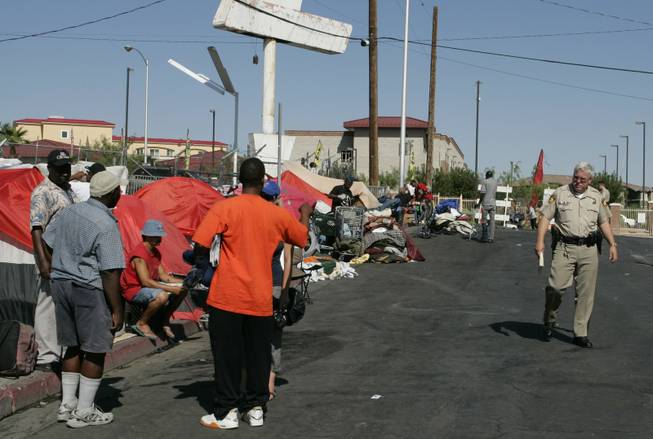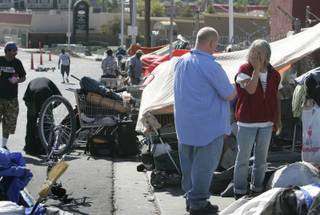
Metro Lt. Ted Snodgrass, right, walks by a homeless encampment on Foremaster Lane Wednesday, July 29, 2009.
Friday, July 31, 2009 | 2 a.m.
Sun Archives
- Street sweeps won't solve street sleep (4-17-2009)
- Metro rethinks 'Don't feed homeless' (4-14-2009)
- Growing homeless settlement vexes business, Goodman (4-3-2009)
- LV City Council addresses homeless issues (3-18-2009)
- Despite pressing needs, wishes are modest (12-22-2008)
- Annie Wilson, Metro Police's liaison to the homeless (12-10-2008)
- First things first: For homeless, a home (4-22-2008)
Two months ago the valley’s largest and most visible tent city appeared headed for a turnaround, with bushels of money and hordes of social service workers coming to help the homeless.
Now the few remaining tents along Foremaster Lane will disappear within weeks, not because the dozens of men and women in them had somewhere better to go, but because Metro Police asked them to leave, an extension of a plan to “take back the area,” Lt. Ted Snodgrass said.
What was at one time a camp of about 300 people is now down to about 50.
When the last tent is gone, does it mean months of work in the area were successful?
Some people involved in the effort say yes. They said 40 to 60 people have been moved into housing or social service programs since May, when the area was the subject of various news reports and visits by Las Vegas City Council members.
But an exact tally of how many got what kind of help was unavailable. Metro Deputy Chief Gary Schofield pointed the Sun to the county’s regional coordinator of services for the homeless, but Jennifer Knight, a county spokeswoman, said she could not provide even a rough estimate because the efforts at Foremaster and Main Street “did not follow regional protocol.”
Nan Roman, president of the National Alliance to End Homelessness, a Washington-based group that advises Congress on the issue, said not having one source of data on the number of people helped and how means one thing: “You really don’t know what was done.”
“So it feels like a solution because the tent city is gone, but it may not be, in the absence of data.”
What is certain is most of the homeless men and women have scattered from the camp increasingly in recent weeks, as Metro’s plan has become clear, signaled by steel barricades stretching along strips of sidewalk, barricades that make it impossible put up tents there.
•••
The tent city’s 15 minutes of fame started this spring, as Las Vegas announced plans to apply for $2.1 million in stimulus funding to help people on and around Foremaster at Main, the so-called homeless corridor. The tent city was one in a series that have popped up in the same area over the past decade. Nearby shelters and the availability of free meals have long drawn street people to the area.
In May, Schofield gathered together dozens of private and public agencies, after a Sun story noted that police were hassling church groups for handing out sandwiches. Those agencies together came up with the Hope Corridor Strategic Plan.
But the hope that the corridor plan and the stimulus money appeared to offer didn’t last long.
First, the federal government made Las Vegas widen its proposal to cover the rest of the city. Then the meetings hosted by Metro shrank by half, as groups experienced in working with the homeless lost patience for debates over policy and strategy. New groups, mostly religious, showed up.
And Metro Police began putting up the barricades, laying claim to land piece by piece. Snodgrass said he decided on this approach about six weeks ago, after the owners of properties in the area asked whether Metro could help clear part of the sidewalk to ensure public access.
In any case, Snodgrass added, the barriers help realize the Hope Corridor Plan’s vision: “Safe streets for all who live and work in the corridor.”
Many of those who lived in the corridor have left for parts unknown, however, so how safe they are remains in question.
The way it was all handled did involve unprecedented, intensive collaboration between public and private agencies, at least, which has included officers “starting to look at these people as people,” Snodgrass said.
Officers accompanying social workers on weekly visits to the tent city announced which stretch of sidewalk would be covered next, giving people time to gather shelters, blankets and bags. As this unfolded, “nobody’s been arrested, nobody’s complained,” Snodgrass said.
First the west side of Main Street was cleared. Then the east side. Next, and last, comes Foremaster.
On Wednesday, the weekly combination of social work, Las Vegas Neighborhood Services Department cleanup and announcements on what’s next played out with dawn’s arrival. The scorching sun brought with it a rising, fetid stench.
A man helped another drag a tent across the street ahead of arriving backhoes and trash bins for clearing garbage.
Ronald Marek and his wife, Cindy, had just moved their belongings in advance of the barricades. Marek pulled from his wallet a Veterans Affairs card, a reminder of his two tours in Vietnam. He told the story about why the couple and their 18-year-old, mentally disabled son came to the camp: a fire in their apartment, no help from any agency, a donated tent. He lifted a pant leg to show burned skin.
Where will they go when the barricades come to Foremaster?
Cindy called to one man, who asked another, who said another camp is forming nearby.
“I guess we’ll go there,” she shrugged.
•••
Roman, a national expert on the subject, said Las Vegas is not the only city to have problems with a central, controversial tent city. Most of them are on public property, but they often cause problems for private businesses and homeowners. Responses have ranged from officials in Portland, Ore., setting aside a “permanent tent city” — “a little more orderly, but not the solution,” Roman said — to New Orleans finding housing for hundreds.
Roman noted that many people living in tent cities are chronically homeless, meaning they have been on the streets the longest and cost society millions of dollars for time in emergency rooms and jails, not to mention short-term services such as shelter accommodations.
“The bottom line,” Roman said, “is that these people have complicated problems and need to be in housing with intensive services. Moving them around from one place to another is a whack-a-mole approach that doesn’t solve the problem.”
Two months of intensive work at the Las Vegas site has brought order to area businesses such as Palm Mortuary and reduced crimes including drug sales and prostitution, Snodgrass said. Also, the large agencies that give the neighborhood its “homeless corridor” name, particularly Catholic Charities and The Salvation Army, have benefitted from increased calm, he said.
“But have we displaced some chronically homeless people? You’d be a fool to say no,” the Metro lieutenant said.
Harry Batiste lives on Foremaster, advocates for his fellow homeless in the camp and wants to be “the last man standing” when the tents are gone.
“It’s been good to see an attempt at openness,” he said of the Metro-led meetings, at least a half-dozen of which he’s attended. He reels off names of people who weeks ago slept in tents next to him and now lie down in beds at apartments across the valley.
But he also knows others who have taken their tents to other streets, and fears they will be cut off from further help.
And where will Batiste go?
“I’ve thought about that moment very seriously. I don’t know for sure.”


Join the Discussion:
Check this out for a full explanation of our conversion to the LiveFyre commenting system and instructions on how to sign up for an account.
Full comments policy